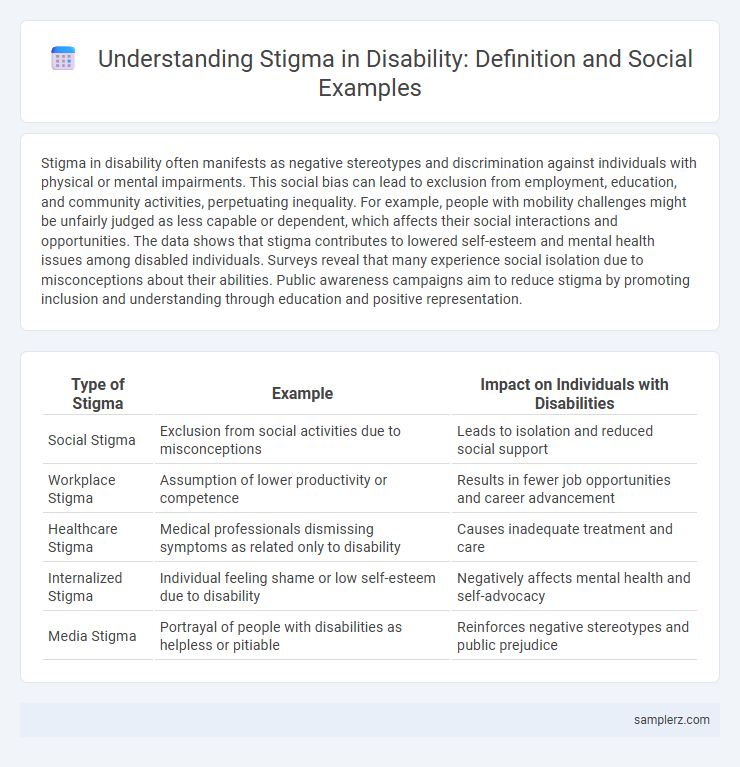Stigma in disability often manifests as negative stereotypes and discrimination against individuals with physical or mental impairments. This social bias can lead to exclusion from employment, education, and community activities, perpetuating inequality. For example, people with mobility challenges might be unfairly judged as less capable or dependent, which affects their social interactions and opportunities. The data shows that stigma contributes to lowered self-esteem and mental health issues among disabled individuals. Surveys reveal that many experience social isolation due to misconceptions about their abilities. Public awareness campaigns aim to reduce stigma by promoting inclusion and understanding through education and positive representation.
Table of Comparison
| Type of Stigma | Example | Impact on Individuals with Disabilities |
|---|---|---|
| Social Stigma | Exclusion from social activities due to misconceptions | Leads to isolation and reduced social support |
| Workplace Stigma | Assumption of lower productivity or competence | Results in fewer job opportunities and career advancement |
| Healthcare Stigma | Medical professionals dismissing symptoms as related only to disability | Causes inadequate treatment and care |
| Internalized Stigma | Individual feeling shame or low self-esteem due to disability | Negatively affects mental health and self-advocacy |
| Media Stigma | Portrayal of people with disabilities as helpless or pitiable | Reinforces negative stereotypes and public prejudice |
Common Stereotypes Faced by People with Disabilities
People with disabilities often face stereotypes such as assumptions of incompetence, dependence, or lack of productivity, which contribute to social exclusion and discrimination. These misconceptions hinder access to education, employment, and social participation, perpetuating systemic barriers. Addressing stigma requires promoting awareness and inclusive policies that recognize the diverse abilities and potential of individuals with disabilities.
Social Isolation and Exclusion in Community Settings
Social isolation and exclusion in community settings profoundly impact individuals with disabilities, often leading to diminished mental health and limited access to social networks. Barriers such as inaccessible public spaces, lack of inclusive programs, and prevailing negative attitudes contribute to their marginalization. Addressing these challenges requires targeted community engagement initiatives and policy reforms that promote inclusivity and social integration for people with disabilities.
Discrimination in Educational Institutions
Discrimination in educational institutions against students with disabilities often manifests through lack of accessible facilities, inadequate support services, and biased attitudes from staff and peers. These barriers contribute to social exclusion and lower academic achievement, perpetuating stigma and limiting opportunities for personal development. Ensuring inclusive policies and training for educators is critical to dismantling stigma and promoting equal educational access for all students with disabilities.
Barriers to Employment Due to Disability Stigma
Disability stigma often leads to significant barriers to employment, including biased hiring practices and workplace discrimination. Employers may incorrectly assume individuals with disabilities are less capable or require excessive accommodations, limiting job opportunities. These stigmatizing attitudes contribute to higher unemployment rates and economic marginalization among people with disabilities.
The Impact of Ableist Language and Attitudes
Ableist language and attitudes perpetuate negative stereotypes that marginalize people with disabilities, leading to social exclusion and reduced opportunities for employment and education. Terms such as "crazy," "invalid," or "disabled" used pejoratively reinforce harmful misconceptions and contribute to internalized stigma. This systemic bias affects mental health and self-esteem, creating barriers to full societal participation and equality.
Media Misrepresentation and Its Effects
Media misrepresentation of disability often perpetuates harmful stereotypes by depicting disabled individuals as either objects of pity or superhuman heroes, which distorts public perception and reinforces social stigma. Such biased portrayals contribute to exclusion and discrimination in employment, education, and social interactions, limiting opportunities for people with disabilities. Accurate, diverse representation in media is crucial to dismantle stigma and promote inclusivity and equal rights.
Family and Cultural Stigma Toward Disabilities
Families often internalize cultural stigma toward disabilities, leading to social isolation and limited support for affected members. In many cultures, disabilities are perceived as a source of shame, which discourages open communication and access to essential services. These stigmatizing beliefs ultimately hinder the social inclusion and well-being of individuals with disabilities within their own families and communities.
Challenges in Accessing Public Spaces and Services
People with disabilities often face significant stigma that manifests in physical barriers and inadequate accommodations in public spaces, limiting their independence and participation in community life. Inaccessible transportation, poorly designed infrastructure, and lack of assistive services create challenges in accessing essential services, fostering social exclusion. These obstacles perpetuate negative stereotypes and reduce opportunities for full societal inclusion and equal rights.
Internalized Stigma Among Individuals with Disabilities
Internalized stigma among individuals with disabilities often manifests as feelings of shame, self-blame, and diminished self-worth, adversely impacting mental health and social participation. Research indicates that this self-stigmatization can lead to increased anxiety, depression, and avoidance of seeking necessary support or accommodations. Understanding and addressing internalized stigma is crucial for promoting empowerment and inclusive social policies for people with disabilities.
Advocacy Efforts to Combat Disability Stigma
Advocacy efforts to combat disability stigma emphasize inclusive education, public awareness campaigns, and policy reforms promoting accessibility and equal rights. Organizations like the World Institute on Disability and disability rights groups collaborate to challenge misconceptions and dismantle barriers in employment and social participation. These initiatives foster empowerment and societal acceptance by highlighting the abilities and contributions of individuals with disabilities.

example of stigma in disability Infographic
 samplerz.com
samplerz.com